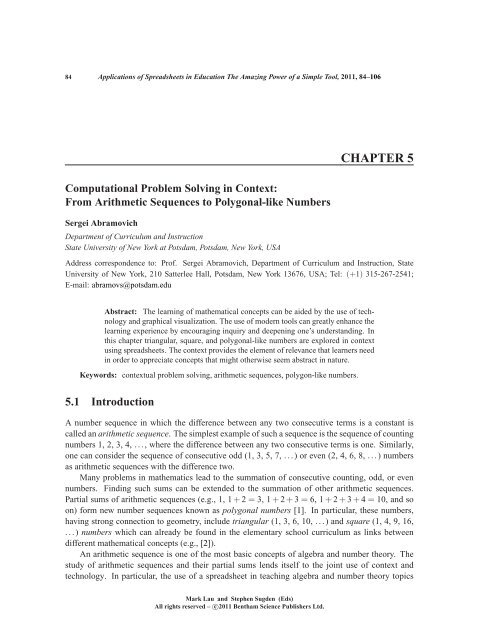chapter 3 - Bentham Science
chapter 3 - Bentham Science
chapter 3 - Bentham Science
You also want an ePaper? Increase the reach of your titles
YUMPU automatically turns print PDFs into web optimized ePapers that Google loves.
84 Applications of Spreadsheets in Education The Amazing Power of a Simple Tool, 2011, 84–106<br />
Computational Problem Solving in Context:<br />
From Arithmetic Sequences to Polygonal-like Numbers<br />
Sergei Abramovich<br />
Department of Curriculum and Instruction<br />
State University of New York at Potsdam, Potsdam, New York, USA<br />
CHAPTER 5<br />
Address correspondence to: Prof. Sergei Abramovich, Department of Curriculum and Instruction, State<br />
University of New York, 210 Satterlee Hall, Potsdam, New York 13676, USA; Tel: (+1) 315-267-2541;<br />
E-mail: abramovs@potsdam.edu<br />
Abstract: The learning of mathematical concepts can be aided by the use of technology<br />
and graphical visualization. The use of modern tools can greatly enhance the<br />
learning experience by encouraging inquiry and deepening one’s understanding. In<br />
this <strong>chapter</strong> triangular, square, and polygonal-like numbers are explored in context<br />
using spreadsheets. The context provides the element of relevance that learners need<br />
in order to appreciate concepts that might otherwise seem abstract in nature.<br />
Keywords: contextual problem solving, arithmetic sequences, polygon-like numbers.<br />
5.1 Introduction<br />
A number sequence in which the difference between any two consecutive terms is a constant is<br />
called an arithmetic sequence. The simplest example of such a sequence is the sequence of counting<br />
numbers 1, 2, 3, 4, ..., where the difference between any two consecutive terms is one. Similarly,<br />
one can consider the sequence of consecutive odd (1, 3, 5, 7, ...) or even (2, 4, 6, 8, ...) numbers<br />
as arithmetic sequences with the difference two.<br />
Many problems in mathematics lead to the summation of consecutive counting, odd, or even<br />
numbers. Finding such sums can be extended to the summation of other arithmetic sequences.<br />
Partial sums of arithmetic sequences (e.g., 1, 1+2=3, 1+2+3=6, 1+2+3+4=10, and so<br />
on) form new number sequences known as polygonal numbers [1]. In particular, these numbers,<br />
having strong connection to geometry, include triangular (1, 3, 6, 10, ...) and square (1, 4, 9, 16,<br />
...) numbers which can already be found in the elementary school curriculum as links between<br />
different mathematical concepts (e.g., [2]).<br />
An arithmetic sequence is one of the most basic concepts of algebra and number theory. The<br />
study of arithmetic sequences and their partial sums lends itself to the joint use of context and<br />
technology. In particular, the use of a spreadsheet in teaching algebra and number theory topics<br />
Mark Lau and Stephen Sugden (Eds)<br />
All rights reserved – c○2011 <strong>Bentham</strong> <strong>Science</strong> Publishers Ltd.

















